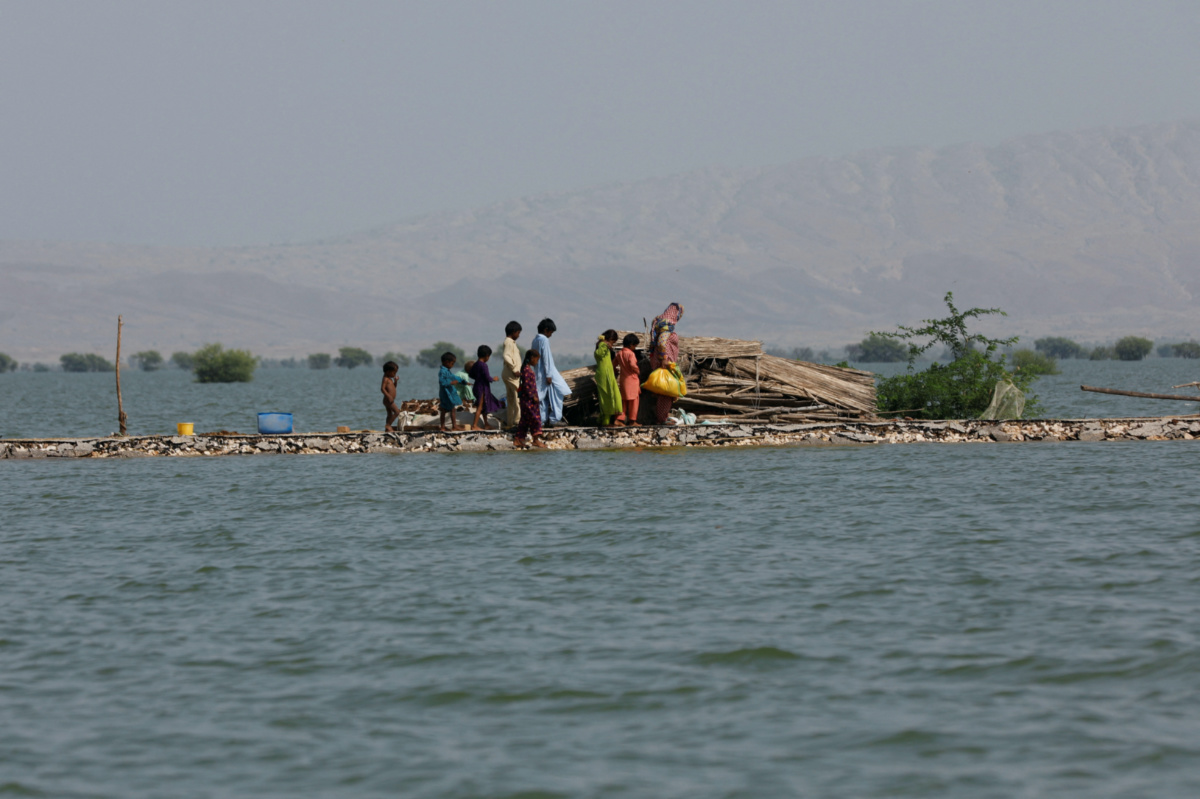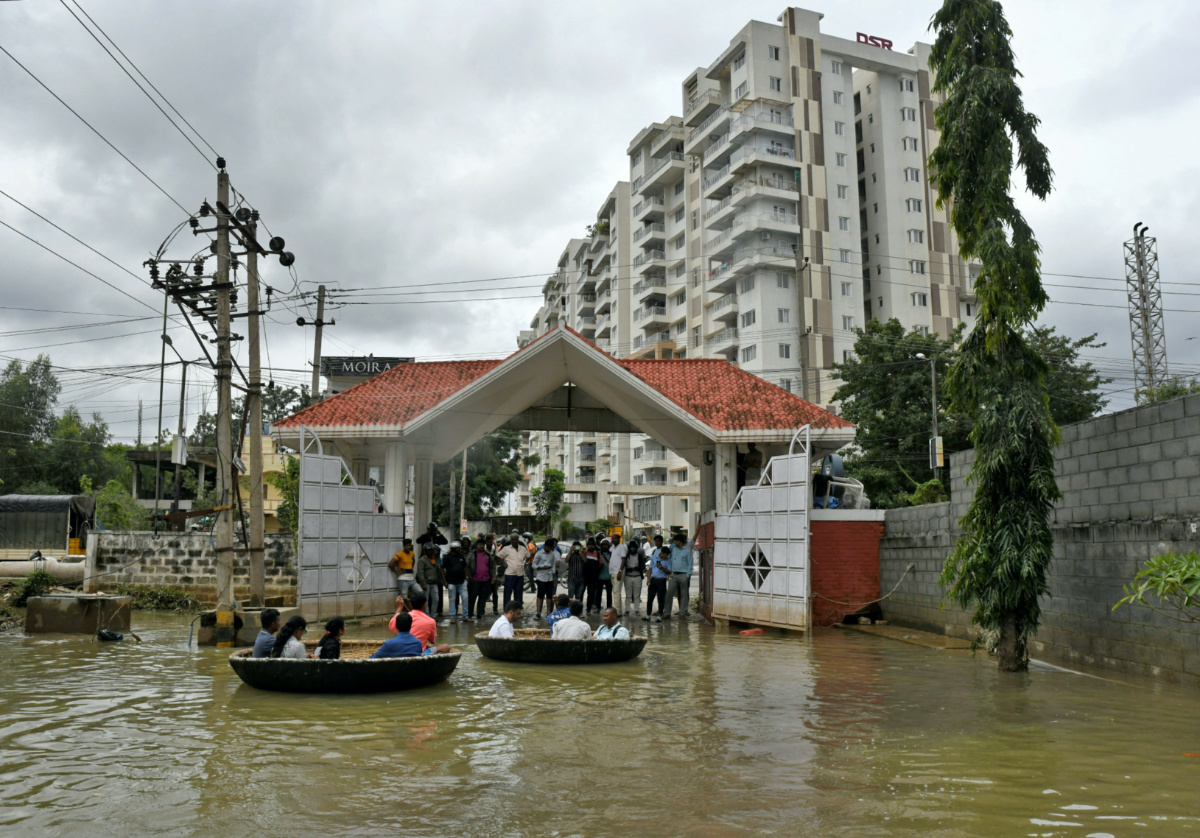Sehwan, Pakistan
Reuters
Parts of Pakistan seemed “like a sea”, Prime Minister Shehbaz Sharif said on Wednesday, after visiting some of the flood-hit areas that cover as much as a third of the South Asian nation, where 18 more deaths took the toll from days of rain to 1,343.

A woman and children walk as they taking refuge along a damaged road amid flood, following rains and floods during the monsoon season in Bajara village, at the banks of Manchar lake, in Sehwan, Pakistan, on 6th September. PICTURE: Reuters/Akhtar Soomro

People use coracle boats to move through a water-logged neighbourhood following torrential rains in Bengaluru, India, on 7th September. PICTURE: Reuters/Samuel Rajkumar
…WHILE IN INDIA, BENGALURU BRACES FOR MORE HEAVY RAIN AFTER SHORT REPRIEVE
India’s technology hub of Bengaluru was gearing up for more heavy rain on Wednesday after a brief respite from severe flooding, as authorities stepped up efforts to evacuate people and pump water out of inundated areas.
India’s “Silicon Valley” is facing an unusually wet monsoon, which has brought 162 per cent more rainfall than average since 1st June. Floods after two days of incessant rain this week brought chaos and killed at least one person.
While flooded roads had cleared in the worst hit areas early on Wednesday, the situation was likely to turn grim again with heavy rain expected later in the day.
“We have issued a red alert for the region. Some pockets may get more than 20 mm of rainfall in an hour,” a senior India Meteorological Department official said.
The Bangalore Urban district on Tuesday received 43.1 millimetres of rain, 585 per cent more than average, according to IMD data.
E-commerce delivery firm Dunzo said it had stopped deliveries in flooded areas and was using trucks to deliver essentials where it could.
The chaos over the past few days has raised questions over poor urban planning as the fast-growing city expanded over the years, and on climate change, which has also been blamed for disastrous floods in neighbouring Pakistan.
The city administration has identified more than 50 areas in Bengaluru that have been encroached upon by high-end villas and apartments.
“Infrastructure continues to be a problem and who do we hold accountable for this situation – the builders who did not account for all of these problems, or the city administration, given the poor lake connectivity and sewage system?” said Garima Sehra, a resident forced to leave her home on Tuesday when her housing complex was flooded.
“We don’t think we can go back for at least a week.”
– NANDAN MANDAYAM and TANVI MEHTA, Bengaluru, India/Reuters
As many as 33 million of a population of 220 million have been affected in a disaster blamed on climate change that has left hundreds of thousands homeless and caused losses of at least $US10 billion, officials estimate.
“You wouldn’t believe the scale of destruction there,” Sharif told media after a visit to the southern province of Sindh. “It is water everywhere as far as you could see. It is just like a sea.”
The government, which has boosted cash handouts for flood victims to 70 billion Pakistani rupees ($US313.90 million), will buy 200,000 tents to house displaced families, he added.
Receding waters threaten a new challenge in the form of water-born infectious diseases, Sharif said.
“We will need trillions of rupees to cope with this calamity.”
The United Nations has called for $US160 million in aid to help the flood victims.
Many of those affected are from Sindh, where Pakistan’s largest freshwater lake is dangerously close to bursting its banks, even after having been breached in an operation that displaced 100,000 people.
National disaster officials said eight children were among the dead in the last 24 hours. The floods were brought by record monsoon rains and glacier melt in Pakistan’s northern mountains.
The raging waters have swept away 1.6 million houses, 5,735 kilometres of transport links, 750,000 head of livestock, and swamped more than 809,370 hectares of farmland.
Officials in Sindh expect the waters to recede in the next few days, said provincial government spokesperson Murtaza Wahab.
“Our strategy right now is to be prepared for wheat cultivation as soon as the water recedes,” he added.
But with more rain expected in the coming month, the situation could worsen further, a top official of the United Nations’ refugee agency UNHCR has warned.
Already, the World Health Organization has said more than 6.4 million people need humanitarian support in the flooded areas.
Pakistan has received nearly 190 per cent more rain than the 30-year average in July and August, totalling 391 millimetres, with Sindh getting 466 per cent more rain than the average.






